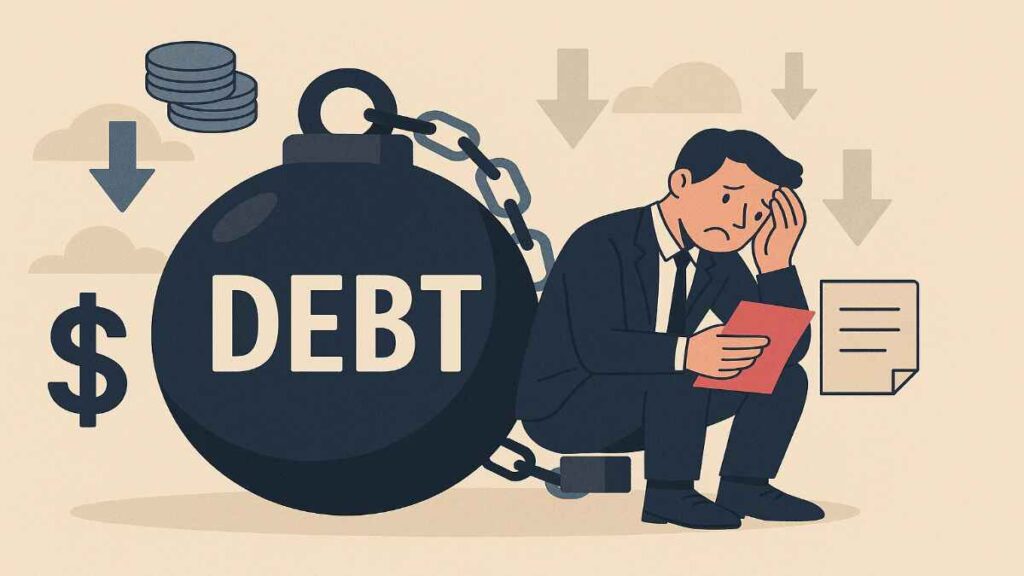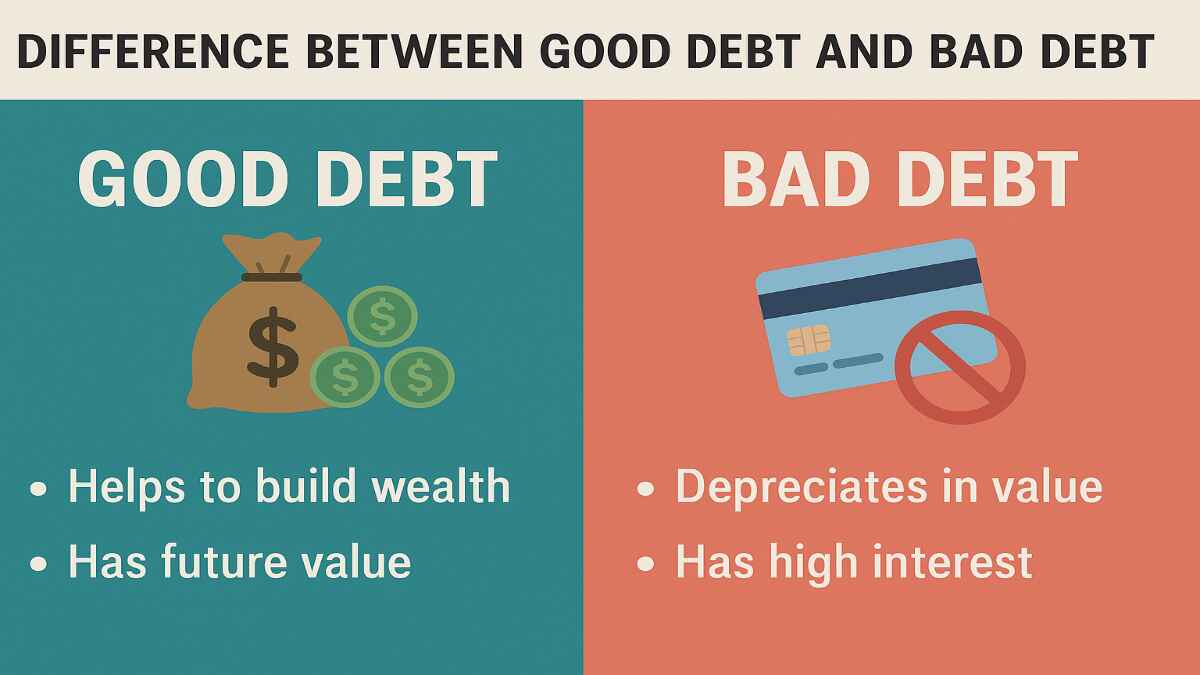Introduction
Debt is a reality for many Indians, whether it’s taking a home loan to buy a dream house, borrowing for education, or using a credit card for daily expenses. However, not all debt is created equal. Understanding the difference between good debt and bad debt is essential for making smart financial choices and securing a stable future. In India, where household debt has risen to 42.9% of GDP by June 2024 (RBI Financial Stability Report), knowing how to borrow wisely can make or break your financial health. This guide explores the difference between good debt and bad debt, provides examples relevant to India, debunks common myths, and offers practical tips for smart borrowing.
Table of Contents
What is Good Debt?
Good debt is borrowing that helps you build assets, generate income, or achieve long-term financial goals. It typically comes with lower interest rates, potential tax benefits, and the ability to increase your net worth. In India, good debt is often associated with investments that align with cultural and economic priorities, such as homeownership and education.
Examples of Good Debt in India
- Home Loans: Buying a house is a significant milestone in India, and home loans are considered good debt because properties often appreciate over time. For example, a ₹50 lakh home loan at 7% interest can lead to wealth creation as the property value grows. Additionally, tax deductions under Sections 80C (up to ₹1.5 lakh on principal) and 24(b) (up to ₹2 lakh on interest) make home loans attractive. Source: Credgenics
- Education Loans: Investing in education can boost earning potential, making education loans a form of good debt. For instance, a ₹10 lakh loan for an engineering degree can lead to a high-paying job, outweighing the cost of borrowing. Tax deductions under Section 80E for interest paid further enhance their value. Source: Credgenics
- Business Loans: Borrowing to start or expand a business can yield significant returns if the venture succeeds. In India’s growing entrepreneurial landscape, a ₹20 lakh business loan could fund a startup that generates profits far exceeding the loan’s cost.
- Loans for Investments: Loans to invest in assets like real estate or stocks can be good debt if the returns exceed the interest paid. For example, a loan to buy a rental property can generate income to cover repayments while the property appreciates.
Characteristics of Good Debt
- Low Interest Rates: Typically below 10%, making repayments manageable.
- Potential for ROI: Investments like property or education can yield long-term gains.
- Builds Net Worth: Helps acquire assets that appreciate or generate income.
- Tax Benefits: In India, home and education loans offer tax deductions, reducing the overall cost.
What is Bad Debt?
Bad debt is borrowing that does not contribute to wealth creation and often comes with high interest rates, leading to financial stress. It is typically used for consumption or depreciating assets, offering no long-term benefits. In India, where consumer credit is growing, bad debt can quickly become a financial burden.
Examples of Bad Debt in India
- Credit Card Debt: Credit cards are convenient but dangerous if not managed properly. With interest rates often exceeding 20% annually, carrying a balance can lead to a debt spiral. For example, a ₹50,000 credit card balance with minimum payments can balloon due to compounding interest. Source: Debt.org
- Personal Loans for Lifestyle Expenses: Borrowing for non-essential expenses like vacations or weddings is bad debt. A ₹2 lakh personal loan at 15% interest for a destination wedding offers no financial return and can strain your budget.
- Payday Loans: These short-term, high-interest loans, sometimes with rates exceeding 30% per month, are used for immediate expenses but can trap borrowers in a cycle of debt. Source: Investopedia
Characteristics of Bad Debt
- High Interest Rates: Often above 15%, increasing the cost of borrowing.
- No Long-Term Benefits: Used for consumption or assets that lose value.
- Financial Stress: Can lead to a debt trap, especially with high-interest loans.
Key Differences Between Good Debt and Bad Debt
The difference between good debt and bad debt lies in their purpose, cost, and impact on your financial future. Here’s a breakdown:
| Aspect | Good Debt | Bad Debt |
|---|---|---|
| Purpose | Builds assets or generates income (e.g., home loans, education loans). | Used for consumption or depreciating assets (e.g., credit card debt, vacation loans). |
| Interest Rates | Lower, typically 6-10% (e.g., home loans at 7%). | Higher, often 15-30% (e.g., credit card debt at 20%+). |
| Return on Investment | Potential to increase net worth (e.g., property appreciation, higher income). | No ROI, often leads to financial loss. |
| Impact on Net Worth | Enhances wealth over time. | Erodes financial stability, can lead to debt traps. |
Myths About Debt in India
Several misconceptions about debt can lead to poor financial decisions. Let’s debunk some common myths:
- Myth 1: All Debt is Bad
Not all debt is harmful. Strategic borrowing, like a home loan for an appreciating property, can build wealth. In India, where homeownership is a cultural priority, good debt is often a necessity. Source: Credgenics - Myth 2: Avoid Debt at All Costs
Avoiding debt entirely may limit opportunities, such as pursuing higher education or starting a business. The key is to borrow wisely and manage repayments effectively. - Myth 3: Credit Cards are Always Bad Debt
Credit cards can be useful if paid off monthly, helping build credit scores and earn rewards. However, carrying a balance turns them into bad debt due to high interest rates.
How to Identify Good Debt vs. Bad Debt
To determine whether a debt is good or bad, ask these questions:
- Does it support long-term financial goals? Good debt aligns with goals like homeownership or education.
- Is the interest rate affordable? Lower rates indicate good debt.
- Will it increase my net worth? Investments in appreciating assets or income-generating opportunities are good debt.
- Can I manage the repayments? Ensure EMIs fit within your budget (ideally below 40% of income).
Managing Good Debt
Even good debt requires careful management to maximize its benefits:
- Timely Repayments: Pay EMIs on time to avoid penalties and maintain a good credit score (CIBIL score above 750 is ideal).
- Budgeting: Include loan repayments in your monthly budget to avoid financial strain.
- Refinancing: If interest rates drop, consider refinancing to lower your costs. For example, refinancing a home loan from 8% to 6.5% can save significant interest. Source: Investopedia
Avoiding Bad Debt

To prevent bad debt, follow these tips:
- Live Within Your Means: Save for non-essential expenses instead of borrowing.
- Use Credit Cards Wisely: Pay off balances monthly to avoid interest charges.
- Explore Alternatives: Use savings or low-cost loans for emergencies instead of high-interest options like payday loans.
Household Debt in India: A Snapshot
Household debt in India is rising, with the debt-to-GDP ratio reaching 42.9% by June 2024, up from 37.6% in March 2023 (RBI Financial Stability Report). Non-housing retail loans, primarily for consumption, account for 55% of total household debt, indicating a shift toward bad debt. Total household debt reached ₹617.3 billion (USD) in March 2024, according to CEIC Data. This trend underscores the importance of distinguishing between good and bad debt to avoid financial stress.
| Debt Type | Share of Household Debt | Purpose | Good or Bad Debt |
|---|---|---|---|
| Housing Loans | ~45% | Asset creation (homeownership) | Good Debt |
| Non-Housing Retail Loans | 55% | Consumption (e.g., personal loans) | Often Bad Debt |
| Consumer Durables | Included in retail loans | Depreciating assets | Bad Debt |
Case Studies
- Good Debt Example: Rohan, a 30-year-old professional, takes a ₹50 lakh home loan to buy a flat in Mumbai. The property appreciates by 5% annually, and he claims tax deductions, reducing the loan’s cost. This is good debt as it builds wealth.
- Bad Debt Example: Priya, a 25-year-old, uses a credit card to fund a ₹1 lakh vacation. Unable to pay the full balance, she incurs 24% interest, leading to financial strain. This is bad debt with no long-term value.
Smart Borrowing in India
Borrowing smartly involves making informed decisions:
- Assess Your Finances: Review income, expenses, and liabilities before borrowing.
- Choose the Right Loan: Match the loan to your goal (e.g., home loan for property, education loan for studies).
- Compare Offers: Use online portals to find the best interest rates and terms.
- Understand Terms: Check for hidden fees, penalties, and repayment schedules.
- Plan Repayments: Keep EMIs below 40% of income to ensure affordability. Source: Credgenics
FAQs
What is the difference between good debt and bad debt?
Good debt builds wealth or income (e.g., home loans), while bad debt is for consumption with no long-term benefits (e.g., credit card debt).
Can loans be good debt?
Yes, if they improve your financial situation, like home or education loans.
What are examples of good debt?
Home loans, education loans, business loans, and investment loans.
Are credit cards always bad debt?
No, if paid off monthly, they can build credit and offer rewards. Carrying a balance makes them ba
Conclusion
The difference between good debt and bad debt is critical for financial success in India. Good debt, like home or education loans, can build wealth and offer tax benefits, while bad debt, such as credit card balances or lifestyle loans, can lead to financial strain. With household debt rising, understanding this distinction and borrowing smartly is more important than ever. By focusing on value-adding investments and managing repayments responsibly, you can use debt as a tool to achieve your financial dreams.
Disclaimer: Moneyjack.in provides general financial information for educational purposes only. We are not financial advisors. Content is not personalized advice. Consult a qualified professional before making financial decisions. We are not liable for any losses or damages arising from the use of our content. Always conduct your own research.
